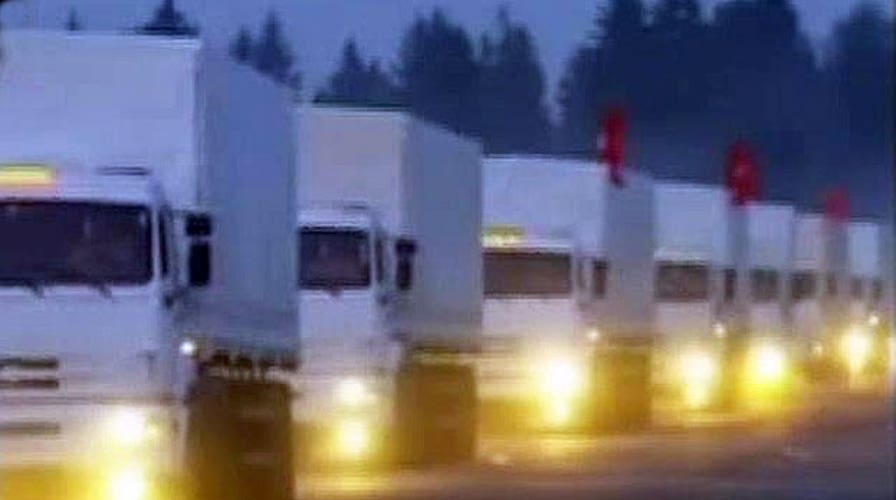Ukraine vows to block Russian aid as NATO warns of invasion
280 aid trucks won't be allowed into Ukraine
Ukrainian officials said Tuesday that 280 trucks thought to be carrying humanitarian aid from Russia to the war-torn eastern Ukraine city of Luhansk would not be allowed to cross the border between the two countries.
Andriy Lysenko, a spokesman for Ukraine's National Security and Defense Council, said the convoy would not be allowed to pass because it had not been certified by the Red Cross. Lysenko also showed a covertly filmed video appearing to show vehicles similar to the white-canopied trucks dispatched from Moscow on Tuesday parked at a military base in Russia.
One frame displayed by Lysenko shows uniformed troops lined up in front of one of the trucks.
Russian television reported early Tuesday that trucks carrying 2,000 tons of humanitarian aid were headed to Ukraine. NTV television showed hundreds of white trucks gathered at a depot outside Moscow, and said they were carrying everything from baby food to sleeping bags. A Russian Orthodox Priest sprinkled holy water on the trucks, some of which bore a red cross, before their departure.
However, Andre Loersch, a spokesman for the Red Cross in Kiev, told The Associated Press by phone that despite the general agreement among all parties, he had "no information about the content" of the trucks and did not know where they were headed.
"At this stage we have no agreement on this, and it looks like the initiative of the Russian Federation," he said.
Lysenko added that “no military structures have the right to escort humanitarian aid convoys, especially into another state."
The government in Ukraine said it is willing for trucks from Russia to unload their contents at the border and for the aid to be transferred to transportation leased by the ICRC. At least 60 miles of the border is currently in rebel hands.
Alexander Drobyshevsky, a spokesman for Russia's emergency ministry that is conducting the mission, told the AP that his organization had "not yet defined" where the trucks would cross the border. He said it could take several days for them to reach Ukraine.
Valeriy Chaly, the deputy head of Ukraine's presidential administration, said a suitable transfer point could be between Russia's Belgorod region and Ukraine's Kharkiv region, which has been spared the major unrest seen further south.
Chaly said that any attempt to take humanitarian goods into Ukraine without proper authorization would be viewed as an attack on the country.
Western officials have repeatedly expressed fears that any Russian aid mission would serve as a precursor to action by Russian ground troops. Late last week, U.S. President Barack Obama, German Chancellor Angela Merkel, and British Prime Minister David Cameron issued statements proclaiming that such action would violate international law.
Ukraine said Monday that it had agreed to send aid to the city of Lunhansk, one of two major rebel enclaves that are still holding out despite being battered by fighting. After announcing the aid mission on Monday, Obama and Ukrainian President Petro Poroshenko agreed that "any Russian intervention in Ukraine without the formal, express consent and authorization would be unacceptable and a violation of international law," according to a White House statement.
Some of the heaviest impact on civilians from fighting has been seen in Luhansk. In their latest status update Monday, city authorities said the 250,000 residents remaining from the pre-war population of 420,000 had had no electricity or water supplies for nine days.
Also on Monday, NATO Secretary-General Anders Fogh Rasmussen told Reuters that there were no signs that Russia had withdrawn any of its troops amassed at the border with Ukraine. When a reporter asked him about the possibility of a Russian invasion, Rasmussen said, "There is a high probability.
"We see the Russians developing the narrative and the pretext for such an operation under the guise of a humanitarian operation, and we see a military build-up that could be used to conduct such illegal military operations in Ukraine," he added.
Ukraine's military claimed that the numbers of Russian troops along the border had risen dramatically. Lysenko told The New York Times that Russia had 45,000 troops at the frontier supported by 160 tanks, 1,360 armored vehicles, 390 artillery systems, 150 truck-mounted ground-to-ground rocket launchers, 192 fighter jets and 137 helicopters. Lysenko's estimates had not been independently verified. NATO has previously estimated that 20,000 Russian troops have gathered at the border.
The United Nations has estimated that more than 1,300 people have been killed in Ukraine since April, when government forces launched a campaign to recapture eastern Ukraine from rebels who had gained control of two provinces under the banner of the Putin-coined term "New Russia."
The other major separatist-controlled city, Donetsk, has been under heavy bombardment from Ukrainian forces. Lysenko said Ukrainian forces were moving closer to encircling the city. At least 300,000 civilians, encouraged by Kiev, are believed to have fled the city, which formerly had a population of 1 million. Residents who have stayed say that mortar and artillery fire can be heard daily. There have been civilian casualties, though estimates vary widely.
The Associated Press contributed to this report.
Click for more from The New York Times.

